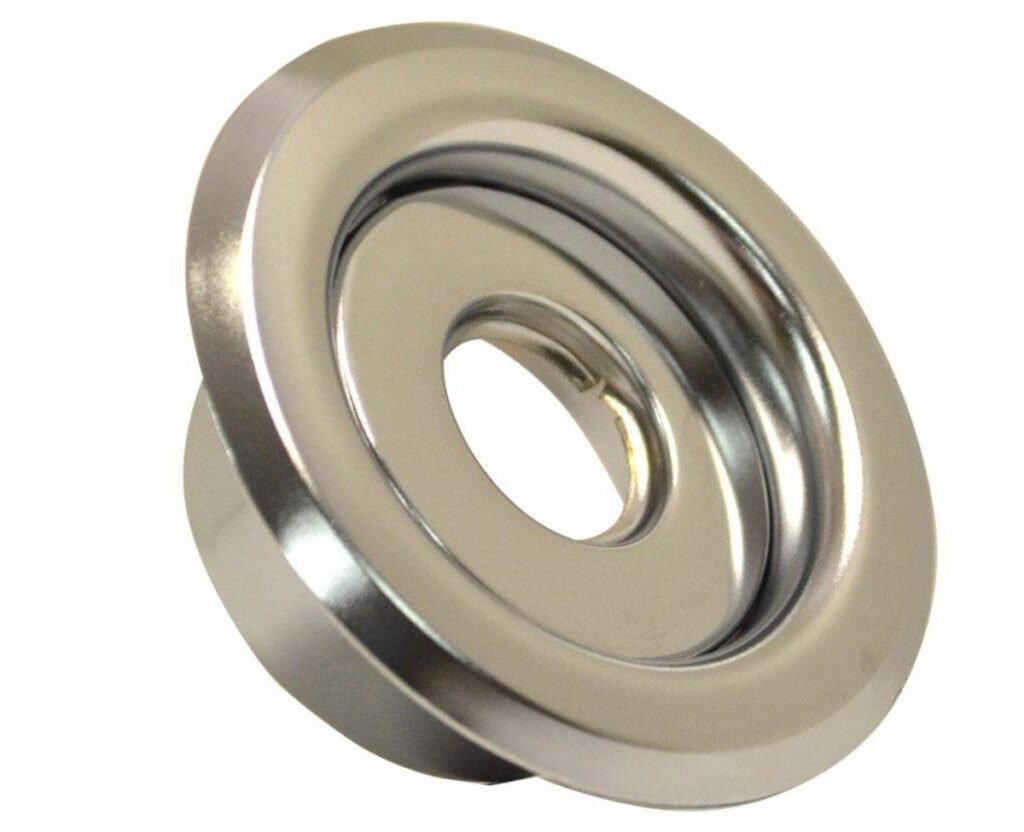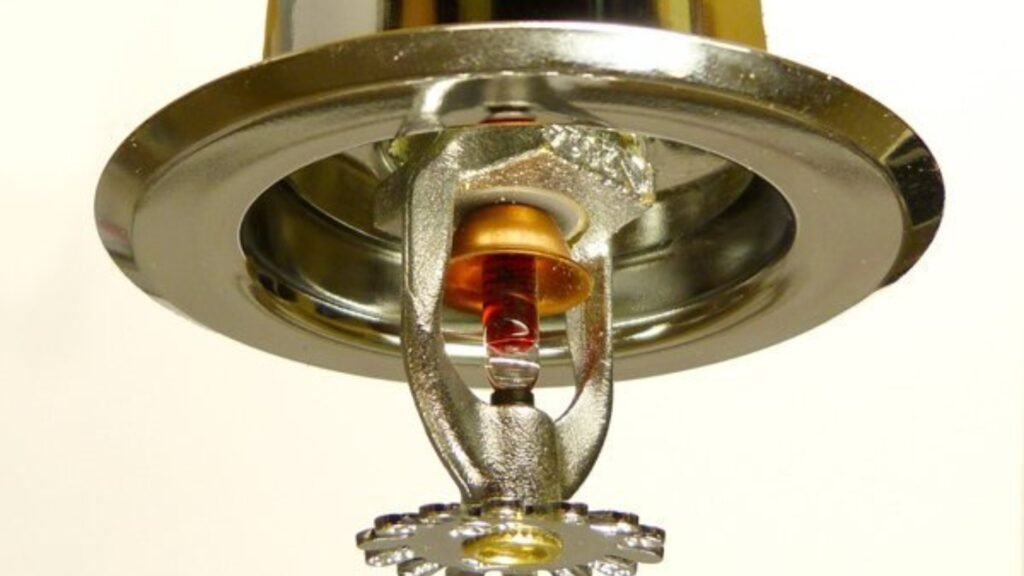Ever wonder what that small metal piece around your shower arm or faucet is called? That decorative ring is an escutcheon plate. This simple yet crucial plumbing component does more than you might think. Escutcheon plates protect your home from water damage. They cover unsightly holes in walls where pipes emerge. These small fixtures make your plumbing look professional and finished.
Let’s explore everything you need to know about escutcheon plates. You’ll learn what they do, why you need them, and how to install them properly.
What Are Escutcheon Plates?
Plumbers also call them flanges or cover plates. You’ll find these fixtures around shower arms, faucets, and toilet water supplies. Chrome, stainless steel, and brass are popular choices. The material you choose should match your other bathroom or kitchen fixtures. These plates serve two main purposes. First, they hide unsightly holes where pipes enter walls. Second, they create a moisture barrier that prevents water from seeping behind fixtures.

The Essential Functions of Escutcheon Plates
Water Protection
Water protection ranks as the most important function of escutcheon plates. Without proper coverage, water can seep into wall cavities. This moisture leads to mold growth, wood rot, and structural damage.
Steam from hot showers can also penetrate these openings. Over time, this moisture causes expensive repair problems. Professional plumbers understand this risk. They never complete installations without proper escutcheon plates. This small investment prevents thousands of dollars in water damage repairs.
Aesthetic Appeal
Escutcheon plates transform rough plumbing connections into finished installations. They cover jagged drywall edges and uneven pipe holes. The result looks clean and professional. These fixtures come in various finishes to match your decor. Polished chrome works well in modern bathrooms. Oil-rubbed bronze suits traditional designs. Brushed nickel offers a contemporary middle ground. The right escutcheon plate completes your fixture’s appearance.
Code Compliance
Most plumbing codes require escutcheon plates on exposed pipe connections. These requirements ensure proper installation standards. They also mandate moisture protection in vulnerable areas.
Building inspectors look for proper escutcheon installation. Missing or improperly installed plates can fail inspection. This delays project completion and adds costs. Professional contractors always include quality escutcheon plates in their installations. This attention to code requirements protects both contractor and homeowner.
Common Types and Applications
Shower Arm Escutcheons
Shower arm escutcheons are the most common type. They slip over the shower arm and rest against the wall. These plates hide the hole where the arm penetrates the shower surround. Installation is straightforward. Remove the shower head first. Slide off the old escutcheon and replace it with the new one. Choose a finish that matches your shower head and trim.
Faucet Escutcheons
Kitchen and bathroom sinks often require escutcheon plates. These cover the holes where supply lines enter the cabinet or wall. They create a finished look around the faucet base. Some faucets include integrated escutcheon plates. Others require separate plates for proper installation. Check your faucet specifications before purchasing additional components. Round plates work for single-hole installations. Rectangular plates cover multiple holes or wider openings.
Toilet Supply Line Escutcheons
Toilet supply lines need escutcheon plates where they enter the wall. These plates hide the rough opening and prevent moisture infiltration. They also improve the overall bathroom appearance. Two-piece hinged escutcheons work best for toilet applications. You can install them without removing the supply valve. This saves time and prevents potential leak issues.
Material Options and Durability
Stainless Steel
Stainless steel offers excellent corrosion resistance. It maintains its appearance in high-moisture environments. This material works well in showers and kitchen applications. Grade 304 stainless steel provides the best combination of strength and corrosion resistance. It costs more than other options but lasts longer. Professional contractors often prefer this material for quality installations.
Brass
Brass escutcheons offer classic appeal and excellent durability. They resist corrosion naturally and develop an attractive patina over time. Many high-end fixtures use brass components. Solid brass costs more than plated alternatives. However, it provides superior longevity and can be refinished if needed. This makes it a good long-term investment.
Chrome-Plated Options
Chrome plating over brass or steel creates an affordable, attractive finish. The bright surface reflects light and makes spaces appear larger. It matches most modern fixtures well. Quality matters with chrome plating. Thin plating wears quickly and looks cheap. Better quality plating lasts longer and maintains its appearance.
Installation Best Practices
Preparation Steps
Start by shutting off the water to the area. Drain the lines by opening nearby faucets. This prevents water spillage during installation. Gather necessary tools before beginning. You’ll need pliers, a soft cloth, and possibly pipe joint compound. Having everything ready speeds up the process.
Removal Process
Remove existing fixtures carefully. Use a soft cloth on plier jaws to prevent scratches. Turn counterclockwise to remove threaded components. Old escutcheons may be stuck with mineral deposits. Soak them in vinegar to dissolve the buildup. This makes removal easier and protects the underlying pipe finish.
Installation Steps
Slide the new escutcheon over the pipe before installing valves or fixtures. This prevents having to remove components later. Test fit everything before final tightening. Apply pipe joint compound to threaded connections. This ensures leak-proof joints and makes future removal easier. Don’t overtighten connections, as this can crack pipes.
Final Adjustments
Adjust pipe positioning if necessary to achieve a proper fit. Tighten connections gradually if seepage occurs.
Maintenance and Replacement
Regular Cleaning
Clean escutcheon plates regularly to maintain their appearance. Use mild soap and water for routine cleaning. Hard water deposits build up over time. Vinegar removes these deposits naturally without damaging finishes. Rinse thoroughly after cleaning to prevent residue.
When to Replace
Replace escutcheon plates when they show significant wear or damage. Scratches, dents, or corrosion indicate replacement time. Don’t wait until they fail. Remodeling projects offer good opportunities for replacement. New plates complement updated fixtures and create a fresh appearance. They’re an inexpensive upgrade with significant visual impact.
Troubleshooting Common Issues
Poor Fit Problems
Escutcheon plates that don’t fit properly allow moisture penetration. Check the opening size before purchasing replacement plates. Standard sizes don’t always fit custom installations. Oversized openings may require larger plates or wall repair. Professional plumbers can recommend the best solution for your specific situation.
Corrosion Issues
Corrosion occurs when moisture penetrates behind plates. This indicates a fit or seal problem. Address the root cause rather than just replacing the damaged plate. A small bead of silicone caulk prevents moisture infiltration while allowing for thermal expansion.
Professional vs. DIY Installation
When to Call Professionals
Complex installations require professional expertise. Multiple pipe penetrations or custom applications need proper planning and execution. Professional installation ensures code compliance and proper function. Plumbers have access to commercial-grade products not available to consumers. They also understand local code requirements and inspection standards. This expertise prevents costly mistakes and callbacks.
DIY Considerations
Simple escutcheon replacements work well as DIY projects. Basic tools and minimal plumbing knowledge are sufficient for most applications. Take your time and follow the manufacturer’s instructions. Purchase quality components even for DIY installations. Cheap escutcheons fail quickly and create more problems. Invest in proper materials for lasting results.
The Foundation of Professional Plumbing
Escutcheon plate represents the attention to detail that separates professional installations from amateur work. They prevent costly water damage through proper moisture management. Quality escutcheons demonstrate craftsmanship and care. They show that every detail matters in creating lasting, functional plumbing systems. Professional contractors understand this principle and never compromise on these essential components.
Your home deserves the protection and finished appearance that proper escutcheons provide. Whether you’re upgrading existing fixtures or planning new installations, make escutcheon plates a priority. This small investment delivers significant long-term value through protection, aesthetics, and peace of mind.

